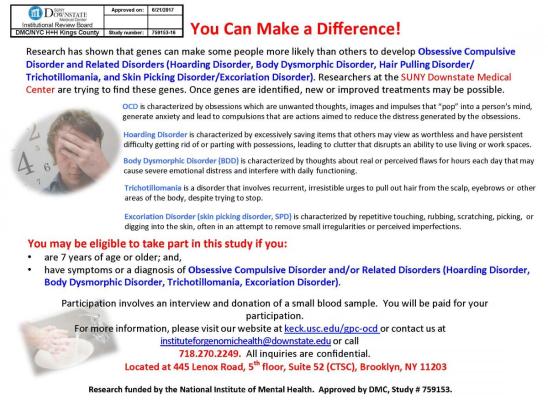Hair Pulling in Children: Looking Through a Developmental Lens

Online test
Find out the severity of your symptoms with this free online test
Trichotillomania (TTM) is an obsessive-compulsive related disorder characterized by the repetitive pulling of hair that results in hair loss. It frequently emerges in childhood and can remain well into adulthood.
Hair pulling behavior is rather common in childhood. In fact, it is frequently seen across the child's developmental continuum, beginning in infancy. Hair pulling can occur for different reasons and often resolves as the child matures. Sometimes, though, the hair-pulling behavior doesn’t resolve and becomes problematic. Over time, it can create distress and impair interpersonal functioning.
Little is known about just how hair pulling develops and persists. Because hair pulling is often seen in the normal developmental process, one group of researchers turned their attention to hair pulling and how understanding this behavior at each developmental phase may be helpful in treatment.
Hair Pulling Across the Developmental Continuum
As they grow, children go through a series of developmental stages. At each stage, they have certain needs to be met and skills to master. Younger kids rely heavily on those around them to nurture and care for them. As they mature, they become more autonomous.
From birth, children are developing schema or patterns of thinking and behaving that help them construct meaning about and manage their world. As they mature, they add to their knowledge base and learn how to navigate their world. Behaviors can either be adaptive and helpful or maladaptive and problematic. Looking at TTM through a developmental lens is a way to understand how hair pulling develops and what its function may be.
The study gathered and analyzed data from a clinic where children with hair loss unrelated to a dermatological disorder were seen for treatment. Parents participated in the study as well. The process consisted of a comprehensive assessment that included clinical, developmental, family, psychosocial, and school history.
Interventions were provided using a multi-framework model that focused on symptoms, family and/or school functioning, parenting styles, and psychoeducational information. The outcome was measured along two dimensions – symptom reduction and family functioning.
Infancy
For babies, behavior is often sensory in nature, seeking to self-soothe or stimulate. The suckling reflex is one of the earliest skills they master. Thumb sucking is a common example and is often accompanied by hair pulling. The baby will recline with hands in the mouth, sometimes twirling either mother’s or their own hair. This type of behavior is often seen when the baby is bored, distressed, or falling asleep. Depending on the child, it may serve as a self-soothing action or as stimulation.
Findings suggest that for children who use hair pulling as a soothing strategy, providing alternatives that are similar in texture to hair (e.g., satin cloth, feathers) might be helpful. Limiting access to hair by using caps, mittens, or short hair cuts were also identified as useful. Other behaviors that co-occur such as thumb sucking should be addressed simultaneously.
The parent-child attachment bond is particularly important during this period. The focus during this developmental period is trust and relying on the parent for the care and nurturing. Self-worth has its roots in this period of life.
Early Childhood – Preschool
For children who pull, the habit is frequently established by this stage. Pulling is typically twisting and plucking, often associated with tantrums, frustration, sadness, or boredom. The child’s primary developmental task during this time is to develop a distinct self, separate from parents.
Findings of the study found that pulling during this time has two dimensions: soothing and autonomy. It becomes something of a transitional object. These are objects that are familiar and comforting and help the child make the emotional transition from one stage to the next.
During this time, the child begins to gain a sense of control over behaviors and begin the push for autonomy. Pulling provides both soothing and stimulation as well as eliciting attention from parents. Tantrums and testing limits are common. Strategies that were found to be helpful in addressing hair pulling were:
- Addressing tantrum behavior via non-reactive, non-reinforcing responses
- Consistency in parenting practices that maintain the parent-child attachment bond
- Providing alternative objects for stimulation and transition (e.g., blankets, soft toys
Early School Age
Children at this age were likely to pull eyelashes and eyebrows as well as scalp hair. Nail-biting was also reported as co-occurring. During this period, hair pulling seemed to be triggered most often by unexpected changes, parental separation, and transitioning to school. Hair pulling seemed to serve as a means of communicating needs and reacting to stressors, indicative of worry or anxiety.
Around this time, children are developing a sense of reality in their world. This is also a period of high creativity. Children communicate through play and other non-verbal ways so they may not use words in the way older children might. Their hair pulling may be seen as a non-verbal way to communicate their distress. They may default to non-verbal behaviors that are comforting such as thumb sucking or hair pulling.
Strategies that were found to be helpful included:
- Encouraging communication and self-expression (verbal and non-verbal)
- Encourage peer interaction and support
- Acknowledge the child’s concerns
Late Childhood
Hair pulling is likely an established habit by this time and most likely done in secret. It is often triggered by high-stress events such as bullying, learning difficulties, or parent-child conflicts.
During this time, children are forming their ideas about values that will guide their decision-making and interests. Peer relationships, especially potential romantic interests, become very important. They also begin to focus on skills achievement, competition, and performance.
Strategies helpful during this period included:
- Encouraging open dialogue. Relentless questioning is not helpful and can shut down the conversation.
- Offering empathic support
- Guidance from role models, extended family members, or mentors may be more accepted than parents
Teens
By this time, hair-pulling behavior is firmly established and resembles trichotillomania. Pulling usually involves scalp hair but can include any part of the body. It may be accompanied by behaviors such as handwashing, excessive cleaning, or similar behaviors. The hair pulling may be associated with rigid thinking or rituals but can be triggered by other high-stress events.
During adolescence, the primary developmental tasks are associated with developing a personal identity, autonomy, and the push for independence. This attempt to separate is normal but can be the source of a tremendous amount of family conflict.
Strategies at this stage went beyond what could be done outside of the clinical setting. The strategies identified as most helpful included:
- a combination of cognitive and behavioral therapies
- family counseling and support
- medication as needed
This research highlights the importance and usefulness of viewing hair pulling through a developmental lens. Treatment can be tailored to meet the child’s needs in an age-appropriate way and include strategies for parents that are compatible with their child’s developmental level. Working together, families can support their loved ones as they heal and grow.
References
1. Santhanam, R., Fairley, M., & Rogers, M. (2008). Is it trichotillomania? Hair pulling in childhood: A developmental perspective. Clinical Child Psychology and Psychiatry, 13(3), 409-418. https://journals.sagepub.com/doi/abs/10.1177/1359104508090604
2. Child development: Examples of developmental stages. (n.d.). Retrieved from https://depts.washington.edu/allcwe2/fosterparents/training/chidev/cd04.htm
Online test
Find out the severity of your symptoms with this free online test
Start your journey with TrichStop
Take control of your life and find freedom from hair pulling through professional therapy and evidence-based behavioral techniques.
Start Now



